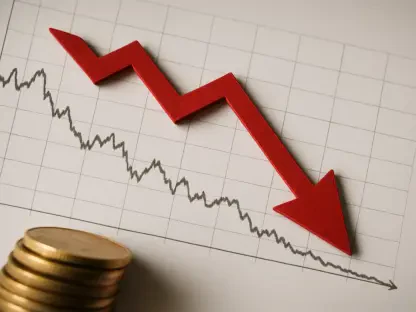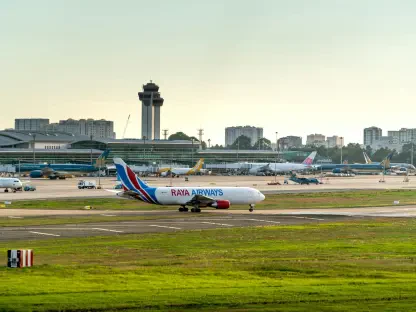The United Kingdom stands at a pivotal moment in its industrial journey, navigating a complex transition from traditional, carbon-intensive steelmaking to sustainable practices powered by electric arc furnaces (EAFs). This shift is driven by an urgent need to align with global climate goals and reduce the steel sector’s significant contribution to greenhouse gas emissions, which account for about 7% of the world’s total. Industry giants such as Tata Steel and British Steel are leading the charge, phasing out aging blast furnaces in key locations like Port Talbot in South Wales and Scunthorpe in favor of EAFs that recycle scrap steel using electricity rather than coal. Yet, this ambitious move toward greener production is fraught with obstacles, chief among them the prohibitively high energy costs in the UK that threaten to derail the economic feasibility of this transformation. As the nation grapples with balancing environmental needs against financial realities, the stakes for both industry and climate policy have rarely been higher.
Environmental Imperative and Opportunities
The Push for Cleaner Steel Production
The drive to decarbonize heavy industries like steelmaking has placed immense pressure on the UK to adopt cleaner technologies, with historic polluters such as the Port Talbot plant coming under intense scrutiny for their environmental impact. Once the nation’s largest single source of CO₂ emissions, this facility alone accounted for one-fifth of Wales’s total greenhouse gas output, highlighting the critical need for change. Electric arc furnaces offer a promising solution by utilizing scrap steel as a primary input, significantly reducing emissions compared to traditional blast furnace methods that rely heavily on coal. This transition not only aligns with international climate commitments but also supports the concept of a circular economy, where materials are reused rather than discarded. The environmental benefits are clear, as EAFs can slash carbon footprints while addressing the steel industry’s outsized role in global warming, positioning the UK as a potential leader in sustainable industrial practices if challenges can be overcome.
Beyond the immediate reduction in emissions, the shift to EAFs represents a broader cultural and policy shift toward sustainability in industrial sectors long criticized for their environmental toll. Government mandates and public expectations are pushing steelmakers to prioritize green methods, with Port Talbot’s transformation serving as a flagship example of what’s possible. This isn’t merely about meeting regulatory targets; it’s about redefining the legacy of an industry that has shaped the UK’s economic history. By adopting EAFs, companies can demonstrate that profitability and environmental responsibility need not be mutually exclusive. However, the success of this pivot hinges on systemic support, particularly in mitigating the financial burdens tied to energy-intensive processes. Without such backing, the environmental gains risk being overshadowed by economic constraints, potentially stalling progress at a time when decisive action on climate change is non-negotiable.
Leveraging Scrap Steel Abundance
The UK’s industrial past provides a unique advantage in the form of abundant scrap steel, accumulated from decades of manufacturing cars, planes, and infrastructure, which can now fuel a recycling-based steel economy. Currently, the country ranks as the world’s largest per capita exporter of scrap steel, sending significant volumes to nations like Turkey and India for processing. By shifting to EAF technology, steelmakers aim to retain more of this resource domestically, potentially increasing self-sufficiency in raw steel production from a mere 18% to as much as 75%. This move could transform the UK into a hub for sustainable steelmaking, capitalizing on a resource that is both plentiful and environmentally beneficial when recycled. Reducing the need to export scrap also means cutting down on the carbon footprint associated with international shipping, further aligning with green objectives.
Moreover, leveraging scrap steel domestically offers strategic benefits beyond environmental gains, as it reduces reliance on volatile global supply chains that have often disrupted production in recent years. For companies like Tata Steel and British Steel, this represents an opportunity to build resilience against external shocks, such as fluctuating raw material costs or geopolitical tensions impacting imports. By focusing on local recycling, the industry can stabilize its input costs and ensure a more predictable production cycle. Yet, this advantage is not without hurdles—processing scrap through EAFs demands substantial electricity, and without affordable energy, the cost of domestic production could outweigh the benefits of reduced import dependency. Thus, while scrap abundance is a powerful asset, its full potential can only be realized by addressing the economic challenges tied to energy pricing in the UK.
Economic and Market Challenges
High Energy Costs as a Barrier
One of the most formidable obstacles to the UK’s green steelmaking transition is the stark disparity in energy costs compared to European competitors, placing domestic steelmakers at a significant disadvantage. Electricity prices in the UK for the period spanning 2025-26 are projected to average £59.48 per megawatt-hour, notably higher than the £52.04 and £47.76 seen in France and Germany, respectively, representing a gap of 14-25%. This difference is particularly problematic for EAFs, which are inherently energy-intensive, requiring vast amounts of electricity to melt scrap steel into usable forms. The elevated costs inflate the price of producing green steel, which can be 30-60% more expensive than traditional blast furnace methods, especially when incorporating innovations like green hydrogen. Without intervention to level the energy cost playing field, the financial burden risks undermining the very environmental benefits that EAFs are intended to deliver.
The ripple effects of high energy costs extend beyond mere production expenses, impacting the broader competitiveness of the UK steel industry in a global market increasingly focused on sustainability. Steelmakers face the dual challenge of meeting domestic demand for greener products while contending with price disadvantages that could drive customers to cheaper, less sustainable alternatives from abroad. Industry voices, including representatives from UK Steel, have repeatedly flagged this price disparity as a critical barrier, warning that it could deter investment in EAF infrastructure at a time when such upgrades are essential. Addressing this issue may require targeted policy measures, such as subsidies or energy price caps for industrial users, to ensure that the transition to low-emission steelmaking remains economically viable. Until such solutions are implemented, the high cost of electricity will continue to cast a shadow over the UK’s green ambitions.
Global Competition and Trade Pressures
In addition to domestic energy challenges, the UK steel industry must navigate a complex web of global market dynamics that further complicate the shift to sustainable production methods. Overproduction in China, which floods international markets with low-cost steel, poses a persistent threat to UK producers already struggling with higher operational costs. Compounding this issue are new import tariffs introduced by the US and EU, designed to protect their own markets from cheap foreign steel but inadvertently squeezing UK exporters caught in the crossfire. These trade barriers limit market access for British steel, making it harder to offset the financial strain of transitioning to EAFs. As a result, the industry finds itself squeezed between rising production costs at home and shrinking opportunities abroad, creating a precarious economic environment.
The global push for greener steel production adds another layer of pressure, as countries with lower energy costs or more aggressive subsidies gain a competitive edge in building green capacity. Nations like China are rapidly expanding their sustainable steelmaking infrastructure, often at a scale and speed that the UK cannot match under current conditions. This disparity risks relegating UK steelmakers to a secondary role in the emerging green economy, despite their early adoption of EAF technology. To counter this, strategic trade agreements or domestic incentives could help level the playing field, ensuring that UK steel remains a viable player on the world stage. Without such measures, the combined weight of global competition and restrictive trade policies could stifle the industry’s ability to fully embrace and benefit from the shift to low-emission production, even as environmental demands grow louder.
Technological and Systemic Limitations
Advances and Limits of EAF Technology
Significant strides in electric arc furnace technology have bolstered confidence in its role as a cornerstone of green steelmaking, challenging outdated perceptions of its capabilities within the industry. Modern EAFs are now equipped to produce nearly 90% of the steel grades traditionally manufactured in blast furnaces, dispelling the myth that they are limited to lower-quality outputs. This versatility makes them a viable replacement for many conventional processes, particularly in recycling scrap steel into high-value products. Such advancements are crucial for the UK, where the focus on reusing existing materials aligns with both environmental goals and resource availability. However, the technological promise of EAFs must be tempered by the reality of their operational demands, which pose unique challenges to widespread adoption in a high-cost energy market.
The primary limitation of EAFs lies in their substantial electricity consumption, which far exceeds that of traditional methods when producing equivalent volumes of steel, amplifying the impact of the UK’s elevated energy prices. This energy intensity means that even with technological improvements, the cost of running EAFs remains a significant barrier, particularly for companies aiming to scale up production to meet market needs. Furthermore, while EAFs excel in recycling scrap, they cannot fully address the global demand for primary steel made from raw materials—a need that is projected to persist as scrap supplies may become insufficient by 2050. This dual reality underscores that while EAFs are a vital tool for decarbonization, they are not a complete solution, requiring complementary strategies to ensure the UK steel industry can meet both domestic and international demands without sacrificing economic stability.
Alternative Methods and UK Constraints
While EAFs dominate the conversation around green steelmaking in the UK, alternative low-emission technologies like direct reduced iron (DRI) plants are gaining attention globally, particularly in regions with access to cheap energy resources. DRI processes, which use natural gas or biomass to produce primary steel from iron ore, offer a pathway to reduce emissions compared to traditional blast furnaces and are being adopted in countries like Saudi Arabia. However, the feasibility of DRI in the UK remains low due to the prohibitive cost of energy, which would render such operations uncompetitive. Additionally, the environmental impact of mining raw ores for DRI production raises further concerns, clashing with the sustainability ethos driving the UK’s industrial transition. As a result, EAFs stand out as the most practical option for now, despite their own set of challenges.
The constraints surrounding DRI and other alternatives highlight a broader systemic issue in the UK—namely, the lack of an energy framework conducive to adopting diverse low-emission technologies on a large scale. Unlike energy-rich nations that can experiment with multiple steelmaking methods, the UK’s high electricity costs narrow the range of viable solutions, locking the industry into a heavy reliance on EAFs. This limitation necessitates a sharper focus on optimizing EAF operations through innovation and energy efficiency measures, as well as advocating for policy changes to reduce power costs for industrial users. Looking back, the journey to this point reveals a missed opportunity to diversify earlier, but moving forward, stakeholders must prioritize actionable reforms to support EAFs. Future considerations should include exploring renewable energy integration to power steel plants and forging international partnerships to secure stable scrap supplies, ensuring the UK’s green steel ambitions are not just a vision but a lasting achievement.









